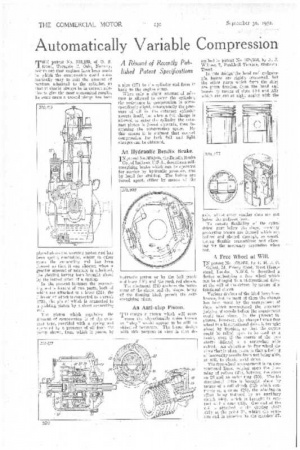Automatically Variable Compression
Page 68

If you've noticed an error in this article please click here to report it so we can fix it.
A Resurn of Recently Pub, lished Patent Specifications TEM patent No. 379,169, of 0. S. Ruud, Torsgate 2, Oslo, Norway, points out that engines have been made in which the compression could automatically vary to suit the amount of mixture admitted to the cylinder, so that it should always be in correct relation to give the most economical results. In some cases a second pistin has been
placed above the working piston and has been spring controlled, whilst in other cases the connecting rod has been formed so that it can shorten when a greater amount of mixture is admitted, the yielding having been brought about by the introduction of a spring.
In the present Instance the connecting rod is formed of two parts, both of which are attached to a lever (21), the fulcrum of which is connected to a crank (23), the pin of which is connected to a yielding piston by a short connecting rod.
The piston which regulates the amount of compression is of the cataract type, provided with a spring and operated by a pressure of oil from the Pump shown, from which it passes by a pipe (27) to the cylinder and from it back to the engine sump.
When only a slight amount of mixture is allowed to enter the cylinder, the resistance to compression is correspondingly slight, consequently the pressure of oil in the cataract cylinder asserts itself, but when a full charge is allowed to enter the cylinder the cataract piston is forced upwards, thus increasing the compression space. 13y this means it is claimed that correct compression for both full and light charges can be obtained.
An Hydraulic Bendix Brake.
IN patent No.3I78,995, theBendix Brake Co.. of Indiana, U.S.A., describes a selfenergizing brake which can be operated for service by hydraulic pressure, and by hand for stalling. The halves are forced apart, either by means of the hydraulic piston or by the bell crank and lever (40) and the push rod shown.
The abutment (24) anchors the movement of the shoes, and the hinges, being of the floating kind, permit the ,self
energizing effect.
An Anti-slap Piston.
To design a piston which will over come the objectionable noise known as "slap" would appear to be still an object of inventors. The latest design with this purpose in view is that de
scribed in patent No. 378,753, by A. J. Wilmer, 7, Pankhali Terrace, Stoke-onTrent.
In this design the head' and gudgeonpin bosses are rigidly connected, but the other parts which form the shirt are given freedom from the head and bosses by means of slots (A4 and A5) which are cut at right angles with the axis, whilst other similar slots are cut below the gudgeon boss.
To ensure flexibility of the cylindrical part below the rings, inwardly projecting bosses are formed which are hollow and !lotted through, so constituting flexible connections and allowing for the necessary expansion when hot.
A Free Wheel at Will.
IN patent No. 378,857, by E. H. J. C. Gillett, 51, Priory Road, West Hampstead, London, N.W.6, is described a device embodying a free wheel which can be changed to a hi-directional drive at the will of the driver, by means of a frictional clutch.
Various devices of the kind have been known, but in most of them the change Jas been made by the engagement of dogs, which necessitated the accurate judging of speeds before the engagement could take place. In the present instance, however, the change from a free wheel to a hi-directional drive is brought about by friction, so that the engine could be relied upon to be used as a brake, even if the speeds of the two shaft ,. differed to a somewhat wide extent. An objection to free-wheel devices that is often heard is that a feeling of insecurity results from not being able, at will, to obtain solid drive.
The free-wheel arrangement is on conventional lines, relying upon the jamming of rollers (29), between the cams on 28 and an outer ring (30). The bidirectional drive is brought about by means of a coil clutch (32) which contracts on a drum (28), the winding-on effect being induced by an auxiliary clutch (40), which is brought in content with a cone (39). One end of the coil is attached to the driving shaft (27) at the point 31, whilst the opposite end is attached to the member 37.






































































































